Casino las vegas wikipedia
Las Vegas
Largest city in Nevada, United States
This article is about the city proper in Nevada. For the metropolitan area, see Las Vegas Valley. For other uses, see Las Vegas (disambiguation).
"Vegas" redirects here. For other uses, see Vegas (disambiguation).
City in Nevada, United States
Las Vegas | |
|---|---|
| Etymology: from Spanish las vegas 'the meadows' | |
| Nicknames: "Vegas", "Sin City", "City of Lights", "The Gambling Capital of the World",[1] "The Entertainment Capital of the World", "Capital of Second Chances",[2] "The Marriage Capital of the World", "The Silver City", "America's Playground" | |
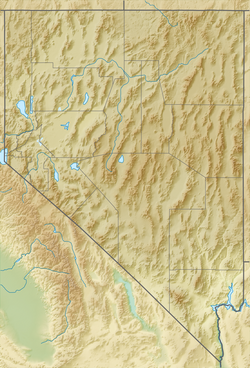 Las Vegas  Las Vegas | |
| Coordinates: 36°10′30″N115°08′11″W / 36.17500°N 115.13639°W / 36.17500; -115.13639 | |
| Country | United States |
| State | Nevada |
| County | Clark |
| Founded | May 15, 1905 |
| Incorporated | March 16, 1911 |
| • Type | Council–manager |
| • Mayor | Carolyn Goodman (I) |
| • Mayor Pro Tem | Brian Knudsen (D) |
| • City council | |
| • City manager | Jorge Cervantes |
| • City | 141.91 sq mi (367.53 km2) |
| • Land | 141.85 sq mi (367.40 km2) |
| • Water | 0.05 sq mi (0.14 km2) |
| Elevation | 2,001 ft (610 m) |
| • City | 641,903 |
| • Rank | 75th in North America 25th in the United States 1st in Nevada |
| • Density | 4,525.16/sq mi (1,747.17/km2) |
| • Urban | 2,196,623 (US: 21st) |
| • Urban density | 5,046.3/sq mi (1,948.4/km2) |
| • Metro [4] | 2,265,461 (US: 29th) |
| Demonym | Las Vegan |
| • Las Vegas (MSA) | $160.7 billion (2022) |
| Time zone | UTC−08:00 (PST) |
| • Summer (DST) | UTC−07:00 (PDT) |
| ZIP Codes | 89044, 89054, 891xx |
| Area code | 702 & 725 |
| FIPS code | 32-40000 |
| GNIS feature ID | 847388 |
| Website | lasvegasnevada.gov |
Las Vegas,[6] often known simply as Vegas, is the most populous city in the U.S. state of Nevada and the county seat of Clark County. The Las Vegas Valley metropolitan area is the largest within the greater Mojave Desert, and second-largest in the Southwestern United States.[7][8] Las Vegas is an internationally renowned major resort city, known primarily for its gambling, shopping, fine dining, entertainment, and nightlife, with most venues centered on downtown Las Vegas and more to the Las Vegas Strip just outside city limits. The Las Vegas Valley as a whole serves as the leading financial, commercial, and cultural center for Nevada. According to the United States Census Bureau, the city had 641,903 residents in 2020,[9] with a metropolitan population of 2,227,053,[10] making it the 25th-most populous city in the United States.
The city bills itself as the Entertainment Capital of the World, and is famous for its luxurious and extremely large casino-hotels. With over 2.9 million visitors as of 2019, Las Vegas is the sixth-most visited city in the U.S., after New York City, Miami, Los Angeles, Orlando, and San Francisco.[11] It is a top-three destination in the U.S. for business conventions and a global leader in the hospitality industry, claiming more AAA Five Diamond hotels than any other city in the world.[12][13][14] Las Vegas annually ranks as one of the world's most visited tourist destinations.[15][16] The city's tolerance for numerous forms of adult entertainment had earned it the nickname "Sin City",[17] and has made Las Vegas a popular setting for literature, films, television programs, and music videos.
Las Vegas was settled in 1905 and officially incorporated in 1911. At the close of the 20th century, it was the most populated North American city founded within that century (a similar distinction was earned by Chicago in the 19th century). Population growth has accelerated since the 1960s and into the 21st century, and between 1990 and 2000 the population nearly doubled, increasing by 85.2%. As with most major metropolitan areas, the name of the primary city ("Las Vegas" in this case) is often used to describe areas beyond official city limits. In the case of Las Vegas, this especially applies to the areas on and near the Strip, which are actually in the unincorporated communities of Paradise and Winchester.[18][19] Over time and influenced by climate change, droughts in Southern Nevada, already one of the driest regions in the United States, have been increasing in frequency and severity,[20] putting a further strain on Las Vegas's water security.
Toponymy
The area was named Las Vegas, which is Spanish for "the meadows", as it featured abundant wild grasses, as well as the desert spring waters needed by westward travelers.[21] The city is often simply called "Vegas".[22][23][24][25][26]
History
Main article: History of Las Vegas
For a chronological guide, see Timeline of Las Vegas.
See also: Las Vegas in the 1940s and Las Vegas in the 1950s
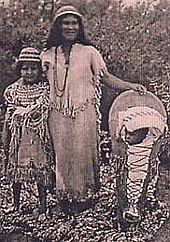
Nomadic Paleo-Indians traveled to the Las Vegas area 10,000 years ago, leaving behind petroglyphs. Ancient Puebloan and Paiute tribes followed at least 2,000 years ago.[27]
A young Mexican scout named Rafael Rivera is credited as the first non-Native American to encounter the valley, in 1829.[28] Trader Antonio Armijo led a 60-man party along the Spanish Trail to Los Angeles, California, in 1829.[29][30] In 1844, John C. Frémont arrived, and his writings helped lure pioneers to the area. Downtown Las Vegas's Fremont Street is named after him.
Eleven years later, members of the Church of Jesus Christ of Latter-day Saints chose Las Vegas as the site to build a fort halfway between Salt Lake City and Los Angeles, where they would travel to gather supplies. The fort was abandoned several years afterward. The remainder of this Old Mormon Fort can still be seen at the intersection of Las Vegas Boulevard and Washington Avenue.
Las Vegas was founded as a city in 1905, when 110 acres (45 ha) of land adjacent to the Union Pacific Railroad tracks were auctioned in what would become the downtown area. In 1911, Las Vegas was incorporated as a city.[31]
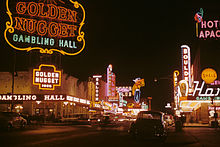
1931 was a pivotal year for Las Vegas. At that time, Nevada legalized casino gambling and reduced residency requirements for divorce to six weeks. This year also witnessed the beginning of construction on nearby Hoover Dam. The influx of construction workers and their families helped Las Vegas avoid economic calamity during the Great Depression. The construction work was completed in 1935.
In late 1941, Las Vegas Army Airfield was established. Renamed Nellis Air Force Base in 1950, it is now home to the United States Air Force Thunderbirds aerobatic team.[32]
Following World War II, lavishly decorated hotels, gambling casinos, and big-name entertainment became synonymous with Las Vegas.

In 1951, nuclear weapons testing began at the Nevada Test Site, 65 miles (105 km) northwest of Las Vegas. During this time, the city was nicknamed the "Atomic City". Residents and visitors were able to witness the mushroom clouds (and were exposed to the fallout) until 1963 when the Partial Nuclear Test Ban Treaty required that nuclear tests be moved underground.[33]
In 1955, the Moulin Rouge Hotel opened and became the first racially integrated casino-hotel in Las Vegas.
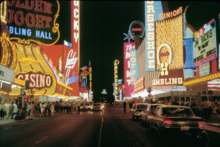
During the 1960s, corporations and business tycoons such as Howard Hughes were building and buying hotel-casino properties. Gambling was referred to as "gaming", which transitioned it into a legitimate business. Learning from Las Vegas, published during this era, asked architects to take inspiration from the city's highly decorated buildings, helping to start the postmodern architecture movement.
In 1995, the Fremont Street Experience opened in Las Vegas's downtown area. This canopied five-block area features 12.5 million LED lights and 550,000 watts of sound from dusk until midnight during shows held at the top of each hour.
Due to the realization of many revitalization efforts, 2012 was dubbed "The Year of Downtown". Projects worth hundreds of millions of dollars made their debut at this time, including the Smith Center for the Performing Arts, the DISCOVERY Children's Museum, the Mob Museum, the Neon Museum, a new City Hall complex, and renovations for a new Zappos.com corporate headquarters in the old City Hall building.[21][34]
Geography

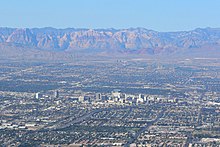
Las Vegas is the county seat of Clark County, in a basin on the floor of the Mojave Desert,[35] and is surrounded by mountain ranges. Much of the landscape is rocky and arid, with desert vegetation and wildlife. It can be subjected to torrential flash floods, although much has been done to mitigate the effects of flash floods through improved drainage systems.[36]
The city's elevation is approximately 2,030 ft (620 m) above sea level, though the surrounding peaks reach elevations of over 10,000 feet (3,000 m) and act as barriers to the strong flow of moisture from the surrounding area. According to the United States Census Bureau, the city has an area of 135.86 sq mi (351.9 km2), of which 135.81 sq mi (351.7 km2) is land and 0.05 sq mi (0.13 km2) (0.03%) is water.
After Alaska and California, Nevada is the third most seismically active state in the U.S. It has been estimated by the United States Geological Survey (USGS) that over the next 50 years, there is a 10–20% chance of an M6.0 or greater earthquake occurring within 50 km (31 mi) of Las Vegas.[37]
Within the city are many lawns, trees, and other greenery. Due to water resource issues, there has been a movement to encourage xeriscapes. Another part of conservation efforts is scheduled watering days for residential landscaping. A U.S. Environmental Protection Agency grant in 2008 funded a program that analyzed and forecast growth and environmental effects through 2019.
Climate
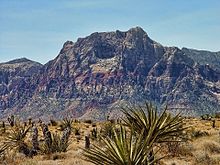
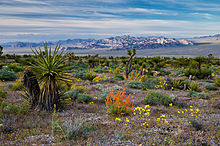
Las Vegas has a subtropicalhot desert climate (Köppen climate classification: BWh), typical of the Mojave Desert in which it lies. This climate is typified by long, extremely hot summers; warm transitional seasons; and short winters with mild days and cool nights. There is abundant sunshine throughout the year, with an average of 310 sunny days and bright sunshine during 86% of all daylight hours.[38][39] Rainfall is scarce, with an average of 4.2 in (110 mm) dispersed between roughly 26 total rainy days per year.[40] Las Vegas is among the sunniest, driest, and least humid locations in North America, with exceptionally low dew points and humidity that sometimes remains below 10%.[41]
The summer months of June through September are extremely hot, though moderated by the low humidity levels. July is the hottest month, with an average daytime high of 104.5 °F (40.3 °C). On average, 137 days per year reach or exceed 90 °F (32 °C), of which 78 days reach 100 °F (38 °C) and 10 days reach 110 °F (43 °C). During the peak intensity of summer, overnight lows frequently remain above 80 °F (27 °C), and occasionally above 85 °F (29 °C).[38]
While most summer days are consistently hot, dry, and cloudless, the North American Monsoon sporadically interrupts this pattern and brings more cloud cover, thunderstorms, lightning, increased humidity, and brief spells of heavy rain. Potential monsoons affect Las Vegas between July and August. Summer in Las Vegas is marked by significant diurnal temperature variation. While less extreme than other parts of the state, nighttime lows in Las Vegas are often 30 °F (16.7 °C) or more lower than daytime highs.[42] The average hottest night of the year is 90 °F (32 °C). The all-time record is at 95 °F (35 °C).[38]
Las Vegas winters are short and generally very mild, with chilly (but rarely cold) daytime temperatures. Sunshine is abundant in all seasons. December is both the year's coolest and cloudiest month, with an average daytime high of 56.9 °F (13.8 °C) and sunshine occurring during 78% of its daylight hours. Winter evenings are defined by clear skies and swift drops in temperature after sunset, with overnight minima averaging around 40 °F (4.4 °C) in December and January. Owing to its elevation that ranges from 2,000 to 3,000 feet (610 to 910 m), Las Vegas experiences markedly cooler winters than other areas of the Mojave Desert and the adjacent Sonoran Desert that are closer to sea level. The city records freezing temperatures an average of 10 nights per winter. It is exceptionally rare for temperatures to reach or fall below 25 °F (−4 °C).[38]

Most of the annual precipitation falls during the winter. February, the wettest month, averages only four days of measurable rain. The mountains immediately surrounding the Las Vegas Valley accumulate snow every winter, but significant accumulation within the city is rare, although moderate accumulations occur every few years. The most recent accumulations occurred on February 18, 2019, when parts of the city received about 1 to 2 inches (2.5 to 5.1 cm) of snow[43] and on February 20 when the city received almost 0.5 inches (1.3 cm).[44] Other recent significant snow accumulations occurred on December 25, 2015, and December 17, 2008.[45] Unofficially, Las Vegas's largest snowfall on record was the 12 inches (30 cm) that fell in 1909.[46] In recent times, ice days have not occurred, although 29 °F (−2 °C) was measured in 1963.[38] On average the coldest day is 44 °F (7 °C).[38]
117 °F (47 °C) is the highest temperature officially observed for Las Vegas, as measured at Harry Reid International Airport on July 10, 2021, the last of five occasions.[38] The lowest temperature was 8 °F (−13 °C), recorded on two days: January 25, 1937, and January 13, 1963.[38] The highest temperature ever measured within the city of Las Vegas was 118 °F (48 °C) on July 26, 1931.[47] The official record hot daily minimum is 95 °F (35 °C) on July 19, 2005, and July 1, 2013. The official record cold daily maximum is 28 °F (−2 °C) on January 8 and 21, 1937.[38]
Due to concerns about climate change in the wake of a 2002 drought, daily water consumption has been reduced from 314 US gallons (1,190 L) per resident in 2003 to around 205 US gallons (780 L) in 2015.[48]
| Climate data for Harry Reid International Airport (Paradise, Nevada), 1991–2020 normals,[a] extremes 1937–present | |||||||||||||
|---|---|---|---|---|---|---|---|---|---|---|---|---|---|
| Month | Jan | Feb | Mar | Apr | May | Jun | Jul | Aug | Sep | Oct | Nov | Dec | Year |
| Record high °F (°C) | 77 (25) | 87 (31) | 92 (33) | 99 (37) | 109 (43) | 117 (47) | 117 (47) | 116 (47) | 114 (46) | 103 (39) | 87 (31) | 78 (26) | 117 (47) |
| Mean maximum °F (°C) | 68.7 (20.4) | 74.2 (23.4) | 84.3 (29.1) | 93.6 (34.2) | 101.8 (38.8) | 110.1 (43.4) | 112.9 (44.9) | 110.3 (43.5) | 105.0 (40.6) | 94.6 (34.8) | 80.5 (26.9) | 67.9 (19.9) | 113.6 (45.3) |
| Mean daily maximum °F (°C) | 58.5 (14.7) | 62.9 (17.2) | 71.1 (21.7) | 78.5 (25.8) | 88.5 (31.4) | 99.4 (37.4) | 104.5 (40.3) | 102.8 (39.3) | 94.9 (34.9) | 81.2 (27.3) | 67.1 (19.5) | 56.9 (13.8) | 80.5 (26.9) |
| Daily mean °F (°C) | 49.5 (9.7) | 53.5 (11.9) | 60.8 (16.0) | 67.7 (19.8) | 77.3 (25.2) | 87.6 (30.9) | 93.2 (34.0) | 91.7 (33.2) | 83.6 (28.7) | 70.4 (21.3) | 57.2 (14.0) | 48.2 (9.0) | 70.1 (21.2) |
| Mean daily minimum °F (°C) | 40.5 (4.7) | 44.1 (6.7) | 50.5 (10.3) | 56.9 (13.8) | 66.1 (18.9) | 75.8 (24.3) | 82.0 (27.8) | 80.6 (27.0) | 72.4 (22.4) | 59.6 (15.3) | 47.3 (8.5) | 39.6 (4.2) | 59.6 (15.3) |
| Mean minimum °F (°C) | 29.8 (−1.2) | 32.9 (0.5) | 38.7 (3.7) | 45.2 (7.3) | 52.8 (11.6) | 62.2 (16.8) | 72.9 (22.7) | 70.8 (21.6) | 60.8 (16.0) | 47.4 (8.6) | 35.2 (1.8) | 29.0 (−1.7) | 27.4 (−2.6) |
| Record low °F (°C) | 8 (−13) | 16 (−9) | 19 (−7) | 31 (−1) | 38 (3) | 48 (9) | 56 (13) | 54 (12) | 43 (6) | 26 (−3) | 15 (−9) | 11 (−12) | 8 (−13) |
| Average precipitation inches (mm) | 0.56 (14) | 0.80 (20) | 0.42 (11) | 0.20 (5.1) | 0.07 (1.8) | 0.04 (1.0) | 0.38 (9.7) | 0.32 (8.1) | 0.32 (8.1) | 0.32 (8.1) | 0.30 (7.6) | 0.45 (11) | 4.18 (106) |
| Average snowfall inches (cm) | 0.0 (0.0) | 0.0 (0.0) | 0.0 (0.0) | 0.0 (0.0) | 0.0 (0.0) | 0.0 (0.0) | 0.0 (0.0) | 0.0 (0.0) | 0.0 (0.0) | 0.0 (0.0) | 0.0 (0.0) | 0.2 (0.51) | 0.2 (0.51) |
| Average precipitation days (≥ 0.01 in) | 3.1 | 4.1 | 2.8 | 1.6 | 1.1 | 0.4 | 2.5 | 2.2 | 1.8 | 1.7 | 1.5 | 3.0 | 25.8 |
| Average snowy days (≥ 0.1 in) | 0.0 | 0.1 | 0.0 | 0.0 | 0.0 | 0.0 | 0.0 | 0.0 | 0.0 | 0.0 | 0.0 | 0.1 | 0.2 |
| Average relative humidity (%) | 45.1 | 39.6 | 33.1 | 25.0 | 21.3 | 16.5 | 21.1 | 25.6 | 25.0 | 28.8 | 37.2 | 45.0 | 30.3 |
| Average dew point °F (°C) | 22.1 (−5.5) | 23.7 (−4.6) | 23.9 (−4.5) | 24.1 (−4.4) | 28.2 (−2.1) | 30.9 (−0.6) | 40.6 (4.8) | 44.1 (6.7) | 37.0 (2.8) | 30.4 (−0.9) | 25.3 (−3.7) | 22.3 (−5.4) | 29.4 (−1.5) |
| Mean monthly sunshine hours | 245.2 | 246.7 | 314.6 | 346.1 | 388.1 | 401.7 | 390.9 | 368.5 | 337.1 | 304.4 | 246.0 | 236.0 | 3,825.3 |
| Percent possible sunshine | 79 | 81 | 85 | 88 | 89 | 92 | 88 | 88 | 91 | 87 | 80 | 78 | 86 |
| Source: NOAA (relative humidity, dew point and sun 1961–1990)[38][40][39] | |||||||||||||
See or edit raw graph data.
Nearby communities

- Boulder City, incorporated
- Enterprise, unincorporated
- Henderson, incorporated
- Lone Mountain, unincorporated
- North Las Vegas, incorporated
- Paradise, unincorporated
- Spring Valley, unincorporated
- Summerlin South, unincorporated
- Sunrise Manor, unincorporated
- Whitney, unincorporated
- Winchester, unincorporated
Neighborhoods
Demographics
| Census | Pop. | Note | %± |
|---|---|---|---|
| 1900 | 25 | — | |
| 1910 | 800 | 3,100.0% | |
| 1920 | 2,304 | 188.0% | |
| 1930 | 5,165 | 124.2% | |
| 1940 | 8,422 | 63.1% | |
| 1950 | 24,624 | 192.4% | |
| 1960 | 64,405 | 161.6% | |
| 1970 | 125,787 | 95.3% | |
| 1980 | 164,674 | 30.9% | |
| 1990 | 258,295 | 56.9% | |
| 2000 | 478,434 | 85.2% | |
| 2010 | 583,756 | 22.0% | |
| 2020 | 641,903 | 10.0% | |
| 2022 (est.) | 656,274 | 2.2% |
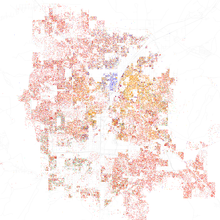
2020 census
This section needs expansion with: examples with reliable citations. You can help by adding to it. (September 2021) |
| Race / Ethnicity (NH = Non-Hispanic) | Pop 2000[55] | Pop 2010[56] | Pop 2020[57] | % 2000 | % 2010 | % 2020 |
|---|---|---|---|---|---|---|
| White alone (NH) | 277,704 | 279,703 | 259,561 | 58.04% | 47.91% | 40.44% |
| Black or African American alone (NH) | 48,380 | 62,008 | 79,129 | 10.11% | 10.62% | 12.33% |
| Native American or Alaska Native alone (NH) | 2,405 | 2,391 | 2,291 | 0.50% | 0.41% | 0.36% |
| Asian alone (NH) | 22,411 | 34,606 | 44,995 | 4.68% | 5.93% | 7.01% |
| Pacific Islander alone (NH) | 1,935 | 3,103 | 4,204 | 0.40% | 0.53% | 0.65% |
| Other race alone (NH) | 650 | 1,101 | 3,855 | 0.14% | 0.19% | 0.60% |
| Mixed race or Multiracial (NH) | 11,987 | 16,985 | 34,040 | 2.51% | 2.91% | 5.30% |
| Hispanic or Latino (any race) | 112,962 | 183,859 | 213,828 | 23.61% | 31.50% | 33.31% |
| Total | 474,434 | 583,756 | 641,903 | 100.00% | 100.00% | 100.00% |
The U.S. Census accounts for race by two methodologies. "Race alone" and "Race alone less Hispanics" where Hispanics are delineated separately as if a separate race.
According to the 2020 U.S. Census, the racial makeup (including Hispanics in the racial counts) was 46.05% (295,594) White alone, 12.85% (82,485) Black alone, 1.14% (7,318) Native American alone, 7.23% (46,398) Asian alone, 0.73% (4,662) Pacific Islander alone, 16.99% (109,045) Other Race alone, and 15.02% (96,401) Multiracial or Mixed Race.[58]
According to the 2020 U.S. Census, the racial and ethnic makeup (where Hispanics are excluded from the racial counts and placed in their own category) was 40.44% (259,561) White alone (non-Hispanic), 12.33% (79,129) Black alone (non-Hispanic), 0.36% (2,291) Native American alone (non-Hispanic), 4.68% (22,411) Asian alone (non-Hispanic), 0.40% (1,935) Pacific Islander alone (non-Hispanic), 0.14% (650) Other Race alone (non-Hispanic), 2.51% (11,987) Multiracial or Mixed Race (non-Hispanic), and 23.61% (112,962) Hispanic or Latino.[57]
2010 census
According to the 2010 Census, the racial composition of Las Vegas was as follows:[59]
Source:[60]
The city's most populous ethnic group, non-Hispanic Whites,[52] have proportionally declined from 72.1% of the population in 1990 to 47.9% in 2010, even as total numbers of all ethnicities have increased with the population. Hispanics or Latinos of any race make up 31.5% of the population. Of those 24.0% are of Mexican, 1.4% of Salvadoran, 0.9% of Puerto Rican, 0.9% of Cuban, 0.6% of Guatemalan, 0.2% of Peruvian, 0.2% of Colombian, 0.2% of Honduran and 0.2% of Nicaraguan descent.[54]
According to research by demographer William H. Frey, using data from the 2010 United States Census, Las Vegas has the second-lowest level of black-white segregation of any of the 100 largest U.S. metropolitan areas, after Tucson, Arizona.[61]
Of the city's Asian residents, according to the city's Asian Chamber of Commerce, Filipinos make up the largest ethnic population within Vegas with over 200,000 in the city.[62][failed verification] Native Hawaiians are also a major demographic in the city, with some Hawaiians and Las Vegas residents calling the city the "ninth island of Hawaii" due to the major influx of Hawaiians to Vegas.[63]
There is an Ethiopian community in Las Vegas.[64][65]
The 2010 census showed the city contained 583,756 people, 211,689 households, and 117,538 families residing.[66] The population density was 4,222.5/sq mi (1,630.3/km2). There were 190,724 housing units at an average density of 1,683.3/sq mi (649.9/km2).
As of 2006, there were 176,750 households, of which 31.9% had children under age 18 living with them, 48.3% were married couples living together, 12.2% had a female householder with no husband present, and 33.5% were non-families. 25.0% of all households were made up of individuals, and 7.5% had someone living alone who was 65 years of age or older. The average household size was 2.66 and the average family size was 3.20.
In the city, the population age distribution was as follows:
- 25.9% under the age of 18
- 8.8% from 18 to 24
- 32.0% from 25 to 44
- 21.7% from 45 to 64
- 11.6% who were 65 years of age or older
The median age was 34 years. For every 100 females, there were 103.3 males. For every 100 females age 18 and over, there were 102.5 males.
The median income for a household in the city was $53,000 and the median income for a family was $58,465.[67] Males had a median income of $35,511 versus $27,554 for females. The per capita income for the city was $22,060. About 6.6% of families and 8.9% of the population were below the poverty line, including 5.4% of those under age 18 and 6.3% of those age 65 or over.
According to a 2004 study, Las Vegas has one of the highest divorce rates.[68][69] The city's high divorce rate is not wholly due to Las Vegans themselves getting divorced. Since divorce is easier in Nevada than in most other states, many people come from across the country for the easier process. Similarly, Nevada marriages are notoriously easy to get. Las Vegas has one of the highest marriage rates of U.S. cities, with many licenses issued to people from outside the area (see Las Vegas weddings).
Economy
The primary drivers of the Las Vegas economy are tourism, gaming, and conventions, which in turn feed the retail and restaurant industries.
Tourism



The major attractions in Las Vegas are the casinos and the hotels, although in recent years other new attractions have begun to emerge.
Most casinos in the downtown area are on Fremont Street, with The STRAT Hotel, Casino & Skypod as one of the few exceptions. Fremont East, adjacent to the Fremont Street Experience, was granted variances to allow bars to be closer together, similar to the Gaslamp Quarter of San Diego, the goal being to attract a different demographic than the Strip attracts.
Downtown casinos
Main article: Downtown (Nevada gaming area)
The Golden Gate Hotel and Casino, downtown along the Fremont Street Experience, is the oldest continuously operating hotel and casino in Las Vegas; it opened in 1906 as the Hotel Nevada.
In 1931, the Northern Club (now the La Bayou) opened.[70][71] The most notable of the early casinos may have been Binion's Horseshoe (now Binion's Gambling Hall and Hotel) while it was run by Benny Binion.
Boyd Gaming has a major presence downtown operating the California Hotel & Casino, the Fremont Hotel & Casino, and the Main Street Casino. The Four Queens also operates downtown along the Fremont Street Experience.
Downtown casinos that have undergone major renovations and revitalization in recent years include the Golden Nugget Las Vegas, The D Las Vegas (formerly Fitzgerald's), the Downtown Grand Las Vegas (formerly Lady Luck), the El Cortez Hotel & Casino, and the Plaza Hotel & Casino.[72]
Las Vegas Strip
Main article: Las Vegas Strip
The center of the gambling and entertainment industry is the Las Vegas Strip, outside the city limits in the surrounding unincorporated communities of Paradise and Winchester in Clark County. Some of the largest casinos and buildings are there.[73]
Welcome signs

The original Welcome to Fabulous Las Vegas sign

Gateway Arches
In 1929, the city installed a welcome arch over Fremont Street, at the corner of Main Street.[74][75][76] It remained in place until 1931.[77][78]
In 1959, the 25-foot-tall Welcome to Fabulous Las Vegas sign was installed at the south end of the Las Vegas Strip. A replica welcome sign, standing nearly 16 feet, was installed within city limits in 2002, at Las Vegas Boulevard and Fourth Street.[79][80][81] The replica was destroyed in 2016, when a pickup truck crashed into it.[82]
In 2018, the city approved plans for a new gateway landmark in the form of neon arches. It was built within city limits, in front of the Strat resort and north of Sahara Avenue.[83] The project, built by YESCO, cost $6.5 million and stands 80 feet high.[84] Officially known as the Gateway Arches, the project was completed in 2020. The steel arches are blue during the day, and light up in a variety of colors at night.[85]
Also located just north of the Strat are a pair of giant neon showgirls, initially added in 2018 as part of a $400,000 welcome display. The original showgirls were 25 feet tall, but were replaced by new ones in 2022, rising 50 feet.[86][87] The originals were refurbished following weather damage and installed at the Las Vegas Arts District.[87][88]
Development
See also: List of tallest buildings in Las Vegas
When The Mirage opened in 1989, it started a trend of major resort development on the Las Vegas Strip outside of the city. This resulted in a drop in tourism in the downtown area, but many recent projects have increased the number of visitors to downtown.
An effort has been made by city officials to diversify the economy by attracting health-related, high-tech and other commercial interests. No state tax for individuals or corporations, as well as a lack of other forms of business-related taxes, have aided the success of these efforts.[89]
The Fremont Street Experience was built in an effort to draw tourists back to the area and has been popular since its startup in 1995.
The city purchased 61 acres (25 ha) of property from the Union Pacific Railroad in 1995 with the goal of creating a better draw for more people to the downtown area. In 2004, Las Vegas Mayor Oscar Goodman announced plans for Symphony Park, which could include a mixture of offerings, such as residential space and office buildings.
Already operating in Symphony Park is the Cleveland Clinic Lou Ruvo Center for Brain Health (opened in 2010), The Smith Center for the Performing Arts (opened in 2012) and the DISCOVERY Children's Museum (opened in 2013).[90]

On land across from Symphony Park, the World Market Center Las Vegas opened in 2005. It currently encompasses three large buildings with a total of 5.1 million square feet. Trade shows for the furniture and furnishing industries are held there semiannually.
Also nearby is the Las Vegas North Premium Outlets. With a second expansion, completed in May 2015, the mall currently offers 175 stores.[91]
City offices moved to a new Las Vegas City Hall in February 2013 on downtown's Main Street. The former City Hall building is now occupied by the corporate headquarters for the online retailer Zappos.com, which opened downtown in 2013. Zappos CEO Tony Hsieh took an interest in the urban area and contributed $350 million toward a revitalization effort called the Downtown Project.[92][93] Projects funded include Las Vegas's first independent bookstore, The Writer's Block.[94]
Other industries
A number of new industries have moved to Las Vegas in recent decades. Zappos.com (now an Amazon subsidiary) was founded in San Francisco but by 2013 had moved its headquarters to downtown Las Vegas. Allegiant Air, a low-cost air carrier, launched in 1997 with its first hub at Harry Reid International Airport and headquarters in nearby Summerlin.
Planet 13 Holdings, a cannabis company, opened the world's largest cannabis dispensary in Las Vegas at 112,000 sq ft (10,400 m2).[95][96]
Effects of growth on water supply
A growing population means the Las Vegas Valley used 1.2 billion US gallons (4.5×109 L) more water in 2014 than in 2011. Although water conservation efforts implemented in the wake of a 2002 drought have had some success, local water consumption remains 30 percent more than in Los Angeles, and over three times that of San Francisco metropolitan area residents. The Southern Nevada Water Authority is building a $1.4 billion tunnel and pumping station to bring water from Lake Mead, has purchased water rights throughout Nevada, and has planned a controversial $3.2 billion pipeline